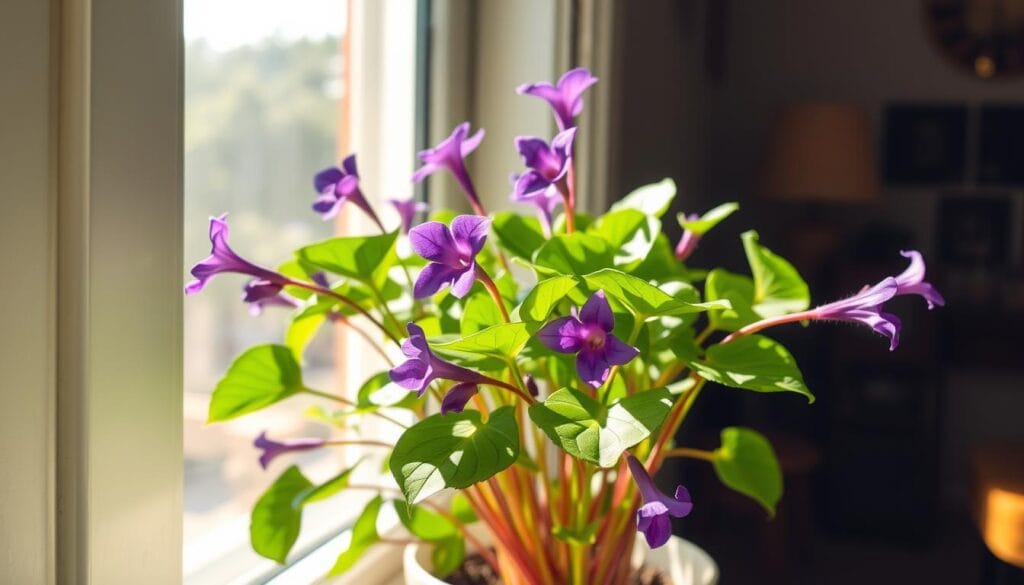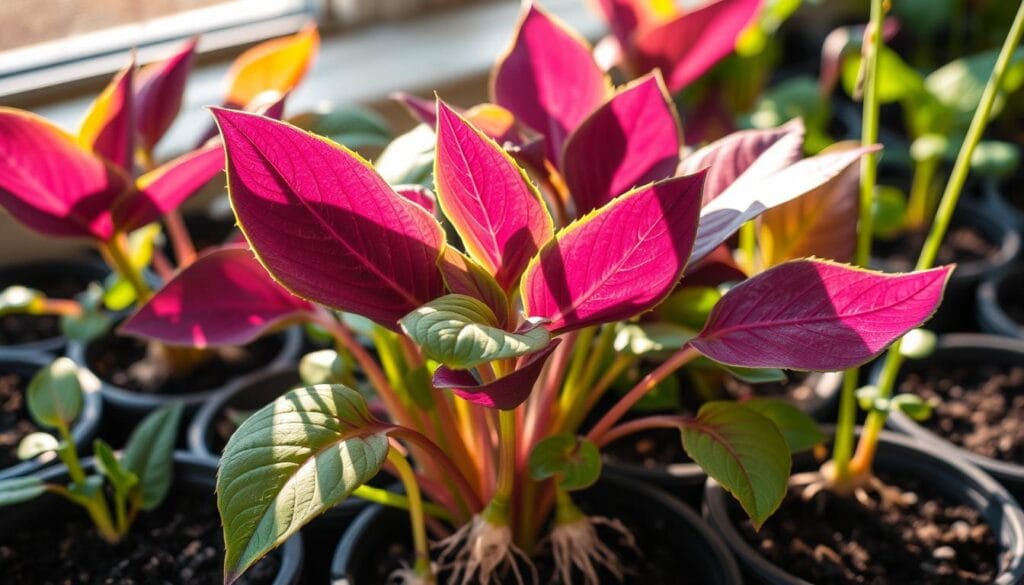The wandering jew plant, also known as Tradescantia zebrina or inchplant, is a captivating and low-maintenance trailing plant. It adds a vibrant touch of greenery to your home or garden. Its striking foliage and easy-to-care-for nature make it a popular choice among plant enthusiasts.
Whether you’re a seasoned gardener or a beginner, this guide will help you grow and care for your wandering jew plant. You’ll learn the secrets to successfully growing this beautiful plant.
Key Takeaways
- The wandering jew plant is a fast-growing, trailing plant with stunning foliage
- It thrives in bright, indirect light and prefers well-draining soil
- Regular watering and moderate humidity are essential for the plant’s health
- Propagation through stem cuttings or water is an easy way to multiply your plant
- Proper pruning and maintenance can help keep the plant looking its best
Understanding the Wandering Jew Plant Species
The wandering-twig, also known as the striped wandering jew or wandering jewel, is a favorite among gardeners. It comes from tropical areas and has many varieties. Each variety has its own look and way of growing.
Common Varieties and Their Characteristics
The Striped Wandering Jew has green and purple striped leaves. The Purple Heart Wandering Jew has deep purple leaves. These plants grow fast and look great in hanging baskets or on shelves.
Natural Habitat and Growth Patterns
- The wandering-twig loves warm, humid places.
- Outside, it can grow really long and spread out.
- Inside, it stays bushy and fits well in pots.
Plant Description and Features
The wandering jew has thick, colorful leaves. They can be purple or green, sometimes with stripes. Its stems are thin and flexible, letting it drape beautifully. With the right care, it’s a beautiful, easy-to-care-for plant for any room.
“The wandering jew plant is a true testament to the beauty and resilience of nature, captivating gardeners and plant enthusiasts alike with its diverse and eye-catching varieties.”
Ideal Growing Conditions for Your Wandering Jew Plant
To grow a purple queen plant or purple heart plant well, you need to know what they like. These plants do best in certain light, temperature, and soil. This is because they are used to their natural habitats.
The wandering jew plant loves bright, indirect light. It can handle some direct sun, but too much can hurt its leaves. A sunny window or a curtain can give it the right light.
When it comes to temperature, these plants like it warm and humid. They do best between 65°F to 85°F (18°C to 29°C). It’s important to keep the temperature steady all year.
| Lighting Preference | Ideal Temperature Range | Humidity Requirements |
|---|---|---|
| Bright, indirect sunlight | 65°F to 85°F (18°C to 29°C) | Moderate to high humidity |
The wandering jew plant also needs good soil. It likes soil that drains well and is full of nutrients. Heavy soils can cause water to pool and rot the roots. Choose a light, airy mix for the best results.
Keeping the air around the plant humid is key. This stops the leaves from drying out. You can mist the leaves or use a pebble tray to add moisture.

By giving your wandering jew plant the right conditions, it will stay healthy and beautiful. This lets it show off its natural charm.
Light and Temperature Requirements
The wandering jew plant, also known as the spiderwort plant or inch plant, needs the right light and temperature. Knowing these needs is key to keeping your plant healthy and vibrant.
Optimal Light Exposure
The spiderwort plant loves bright, indirect sunlight. It can handle some direct sun, but too much can harm the leaves. Place your inch plant where it gets bright, filtered light for several hours a day. This could be near a sunny window or under a sheer curtain.
Temperature Range and Climate Control
The wandering jew plant thrives in temperatures between 65°F and 80°F (18°C to 27°C). It can’t handle extreme temperatures for long. If your climate has big temperature changes, use a greenhouse or indoor grow light to keep your plant happy.
Seasonal Adjustments
As seasons change, your plant’s light and temperature needs might too. In winter, move your inch plant closer to a south-facing window for more light. In summer, give it some shade or move it to a spot with less direct sun to avoid heat stress.

Soil, Water, and Humidity Needs
For your tradescantia zebrina, also known as the wandering jew or inchplant, the right soil and care are key. They like a soil mix that drains well and is slightly acidic. This mix should hold moisture but not get too wet.
Watering is important for these plants. They like consistent moisture but don’t like wet feet. Check the soil’s top inch for dryness before watering. This prevents stress and keeps the leaves healthy.
- Water every 7-10 days, adjusting for temperature and humidity.
- Mist leaves often or use a pebble tray for more humidity.
- Make sure the pot has holes for drainage to avoid waterlogging.
With the right soil, water, and humidity, your tradescantia zebrina will flourish. It will show off its bright leaves in your home.

“Wandering jew plants are resilient and can adapt to a range of growing conditions, but paying attention to their soil, water, and humidity needs will ensure they reach their full potential.”
Propagation Methods and Techniques
Propagating a wandering jew plant is rewarding and saves money. It’s great for both new and seasoned gardeners. Knowing how to propagate these plants helps you grow them well.
Stem Cutting Propagation
Stem cutting is a top choice for growing wandering-twig plants. Cut a 4-6 inch stem just below a leaf node. Then, remove the lower leaves and put it in moist potting mix or water.
Keep the soil or water moist. Soon, you’ll see new roots growing.
Water Propagation Steps
- Fill a clean jar or container with fresh, dechlorinated water.
- Carefully remove a 4-6 inch stem cutting from the plant, just below a leaf node.
- Place the cutting in the water, making sure the lower leaves are submerged.
- Set the container in a bright, indirect light location and change the water weekly.
- In 2-4 weeks, you should see new roots begin to form at the base of the cutting.
Soil Propagation Guidelines
For soil propagation, prepare a well-draining potting mix. Fill a clean container or pot with it. Insert the stem cutting, burying the lower leaves and node.
Water the soil well and keep it moist but not too wet. Place it in a warm, bright spot. Watch for new growth, which may take 3-6 weeks.

Success in propagating wandering jew plants comes from patience and attention to detail. With care and the right conditions, you can multiply your plants. Share them with friends or grow your collection.
Common Problems and Troubleshooting
Caring for outdoor succulent plants like the striped wandering jew and wandering jewel is rewarding. But, it comes with its own set of challenges. Knowing how to handle common problems is crucial for a healthy garden.
Pest infestations are a big issue. Aphids, mealybugs, and spider mites can harm your plants. They cause leaves to turn color, grow slowly, and even die. Regular checks and quick action with organic soaps or neem oil can help control pests.
Diseases like powdery mildew and root rot are also a problem. Good soil drainage, less water in cooler months, and more air around plants can prevent these. If you see disease, cut off the sick parts and use a fungicide made for succulents.
Extreme temperatures, drought, or too much sun can stress out striped wandering jew and wandering jewel plants. Watch their needs closely. Adjust water, shade, and temperature to keep them happy.
| Common Issue | Potential Causes | Recommended Solutions |
|---|---|---|
| Pests | Aphids, mealybugs, spider mites | Use organic insecticidal soaps or neem oil |
| Diseases | Powdery mildew, root rot | Improve soil drainage, reduce watering, increase air circulation, treat with fungicide |
| Environmental Stress | Extreme temperatures, drought, excessive sunlight | Adjust watering, shading, and temperature as needed |
By being proactive and quick to solve problems, your outdoor succulents can flourish for many years.

Pruning and Maintenance Tips
To keep your purple queen or purple heart plant looking great, you need to prune and care for it regularly. These tips will help you keep your plant healthy and looking good. They’ll also help it grow well and keep its beautiful leaves.
Regular Trimming Techniques
Trimming the stems and leaves helps your plant grow bushy and not too long. Use sharp shears or scissors to cut off any dead or too-long leaves. Make sure to cut just above a leaf node to encourage new growth.
Shape Maintenance Guidelines
Wandering jew plants can grow in many shapes, like vines or mounds. To keep your plant looking the way you want, trim the stems now and then. This will help your purple queen plant or purple heart plant stay lush and full.
Tools and Best Practices
- Use sharp, clean pruning shears or scissors for a clean, precise cut
- Disinfect your tools between uses to prevent the spread of disease
- Prune in the spring or summer when the plant is actively growing
- Avoid cutting more than one-third of the plant at a time to prevent stress
- Dispose of trimmings properly to maintain a tidy growing area
By following these easy tips, your purple queen plant or purple heart plant will stay vibrant and healthy. It will also keep its beautiful shape.
Decorative Uses and Styling Ideas
The wandering jew plant, also known as the spiderwort plant or inch plant, is great for home decor. It’s versatile and adds beauty to any room. You can show it off in many creative ways.
One cool way to display it is in a hanging basket. The plant’s vines hang down, making a beautiful centerpiece. You can also mix it with other plants for a more dramatic look.
Terrariums are another great choice. They keep the inch plant happy and let its colors pop. The glass shows off the plant’s vibrant colors and patterns.
For a layered look, mix the wandering jew with other plants in a container. Succulents or ferns work well together. This creates a stunning display that’s easy to care for.
“The spiderwort plant is a versatile and easy-to-care-for addition to any indoor space, offering a splash of color and natural charm to your home decor.”
Conclusion
In this article, we’ve explored the captivating world of the wandering jew plant, also known as Tradescantia zebrina. These stunning, trailing plants add a touch of natural elegance to any space. They are also surprisingly easy to care for, making them perfect for both seasoned gardeners and beginners.
We’ve covered everything from understanding the plant’s unique characteristics to mastering the ideal growing conditions. You now know how to successfully introduce the wandering jew plant into your home or garden. By following the tips and techniques in this guide, you’ll enjoy the vibrant foliage and cascading vines of this versatile plant.
Whether you want to add lush greenery to your living room or brighten up a shaded patio, the wandering jew plant is a great choice. So, embrace your green thumb, put your newfound knowledge into practice, and let the beauty of the wandering jew plant transform your space.





